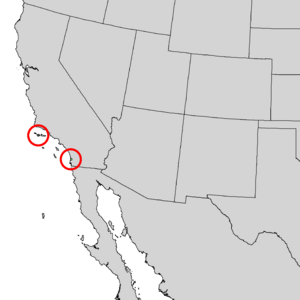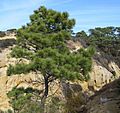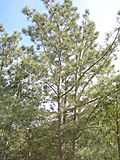Torrey pine facts for kids
Quick facts for kids Pinus torreyanaTorrey pine |
|
|---|---|
 |
|
| A Torrey pine on the northeast coast of Santa Rosa Island, California | |
| Conservation status | |
| Scientific classification | |
| Genus: |
Pinus
|
| Species: |
torreyana
|
 |
|
| Natural range of Pinus torreyana | |
The Torrey pine, also known as Pinus torreyana, is a very rare type of pine tree found only in California, United States. It is a critically endangered species, meaning it is at high risk of disappearing forever. These special trees grow in just a few places: San Diego County (in the Torrey Pines State Natural Reserve and the nearby town of Del Mar), and on Santa Rosa Island and San Miguel Island off the coast of Santa Barbara. The Torrey pine is endemic to this area, which means it naturally grows nowhere else in the world.
Contents
What's in a Name? The Torrey Pine's Story
The scientific name for the Torrey pine, torreyana, honors John Torrey. He was an important American botanist, a scientist who studies plants. Another group of cone-bearing trees, called Torreya, is also named after him.
Meet the Torrey Pine: Appearance and Features
The Torrey pine is a wide tree with an open, spreading top. In the wild, it usually grows about 8 to 17 meters (26 to 56 feet) tall. Its long leaves, called needles, are about 25 to 30 centimeters (10 to 12 inches) long. These needles grow in groups of five.
Pine Cones and Seeds
The tree's cones are thick and heavy. They are typically 8 to 15 centimeters (3 to 6 inches) long and wide. Inside these cones are large, hard-shelled seeds called pine nuts. These pine nuts are safe to eat!
Needles and Strobili
Like all pine trees, the Torrey pine's needles are grouped together in small bundles called 'fascicles'. Each bundle on a Torrey pine has five needles. Pine trees also have structures called strobili, which act like flowers. Male strobili on a Torrey pine look like small yellow buds. Female strobili look like tiny red cones.
Witch's Broom: A Tree Oddity
Sometimes, Torrey pines can get something called "witch's broom" or "gorilla's nest." This is a very thick cluster of needles that looks a bit like a bird's nest. It happens because of a disease or other problems.
Two Types of Torrey Pines
There are two main types, or varieties, of Torrey pine. They have slight differences in how they look and where they grow:
Where Torrey Pines Live: Their Natural Home
Today, wild Torrey pines only grow in a small area along the Southern California coast in San Diego. There's also a group of the Pinus torreyana var. insularis variety on Santa Rosa Island. This island is one of the California Channel Islands near Santa Barbara.
Why They Live There
The presence of Torrey pines in these dry coastal areas (where it rains less than 15 inches per year) is likely a leftover from the Ice Age. Back then, they probably grew in many more places. Coastal fog during spring and summer helps these trees survive. It gives them just enough moisture to add to the low winter rainfall.
How Torrey Pines Grow and Interact with Nature
The Torrey pine's natural home is a type of plant community called coastal sage scrub. These trees grow slowly in dry, sandy soil. They have a very large root system. Even a tiny seedling can quickly send a taproot down 60 centimeters (2 feet) to find water and food. A fully grown tree can have roots that spread out as far as 75 meters (246 feet)!
Shaped by the Wind
Trees that are exposed to strong coastal winds often get twisted into beautiful, sculptural shapes. They can look like large bonsai trees. These wind-battered trees rarely grow taller than 12 meters (39 feet).
Seed Dispersal: How Seeds Travel
Birds and small animals like rodents eat the seeds of the Torrey pine. Most pine seeds have a wing to help them fly in the wind. However, the Torrey pine's seed wing is thin and breaks off easily, so it doesn't work for flying. This means the tree relies completely on animals to spread its seeds. The scrub jay is the most important bird for spreading these seeds on the mainland. Scrub jays and squirrels are thought to be helping the species spread into nearby parklands from gardens around San Diego.
Other Life Connected to the Tree
The caterpillars of a moth called Gloveria arizonensis have been seen eating this tree in the wild. To help Torrey pine seeds sprout, they often need to go through a process called stratification. This means keeping the seeds cold and moist for a while.
Uses of the Torrey Pine
Food Source
The pine nuts from Torrey pines were once an important food for the Kumeyaay tribe of Native American people.
Growing Torrey Pines for Beauty
Even though it's an endangered species in the wild, the Torrey pine is often planted as an ornamental tree (a tree grown for its beauty) around San Diego and other parts of southern California. A single tree planted in a San Diego suburb in the 1940s or 1950s grew to be 33 meters (108 feet) tall! Some sources say it can grow up to 45 meters (148 feet) tall when cultivated. You can buy Torrey pines from many plant nurseries in California.
Forestry Use
Pinus torreyana has also been considered for use in plantations for forestry (growing trees for wood) in countries like Australia, New Zealand, and Kenya.
A Local Icon
In San Diego County, the Torrey pine is a local symbol. Many places are named after it, including Torrey Pines State Reserve, Torrey Pines State Beach, Torrey Pines Golf Course, Torrey Pines High School, and Torrey Pines Gliderport. You'll also find many local businesses and roads with "Torrey Pines" in their names.
Protecting the Torrey Pine: Conservation Efforts
There's some debate about the exact number of Torrey pines left. Generally, only the trees in Torrey Pines State Reserve (TPSR) and on Santa Rosa Island are counted as the wild population. Trees planted in gardens around San Diego are not included.
Challenges to Survival
In the 1970s, it was thought there were about 9,000 Torrey pines in the TPSR and on Santa Rosa Island. However, many of these trees have since died. This was due to forest fires, dry weather (drought), and attacks from a type of bark beetle. Air pollution has also stressed the trees. In the early 1900s, only about a hundred trees were left.
Current Population Estimates
As of 2016, the California Native Plant Society believes there are about 3,000 Torrey pines. In 2011, Aljos Farjon, who studied the species for the IUCN, estimated the total population was 4,500 trees. He noted that the number of trees is slowly decreasing, especially those not protected within the TPSR on the mainland.
Local Protection
The Torrey pine is so important that the city of Del Mar, which is near its natural habitat, has a special law to protect it. People and construction projects need a permit to remove a Torrey pine tree.
Images for kids
-
Torrey pine: female pine cones
-
A wild Torrey pine grove, Santa Rosa Island, California
See also
 In Spanish: Pino de Torrey para niños
In Spanish: Pino de Torrey para niños








